- Publisher's Note
- Editorial
- Love of Life (that) Spills Over
- A Continuing Multiplication
- From Painting to Print
- Intimate Involvement
- Portrait of the Artist as an Old Man
- (Hi)Story of the Garhi Printmaking Studios, New Delhi
- Surinder Chadda
- Ramendranath Chakravorty
- Group 8
- Mother and Child: A Screenplay
- Straddling Worlds
- A Brief History of Printmaking at Santiniketan
- Vignettes from History
- Southern Strategies
- The Forgotten Pioneer: Rasiklal Parikh
- Printmaking in the City Of Joy
- Amitabha Banerjee: His Art and Aesthetic Journey
- Local Style and Homogenizing trends: Early Medieval Sculpture in Galaganatha
- English China: Delicate Pallid Beauty
- The Beauty of 'Bilal'
- Photo Essay
- The Way of The Masters: The Great Artists of India 1100 –1900
- Striving Towards Objectivity
- The Art of Sculpting In the Contemporary Times
- An Artistic Framework for an Alternative to Ecology
- Bidriware and Damascene Work in Jagdish and Kamla Mittal Museum of Indian Art
- A Lowdown on the Print Market
- The 'bubble' and the 'wobble'
- What Happened and What's Forthcoming
- Art Bengaluru
- Art Events Kolkata: June – July 2011
- Musings from Chennai
- Mumbai Art Sighting
- Previews
- In the News
- Christie's Jewellery Auction at London, South Kensington
ART news & views
Vignettes from History
Volume: 3 Issue No: 19 Month: 8 Year: 2011
The early years of printmaking in Baroda
by Sandhya Bordewekar
It was towards the end of the 19th century, during the years that Raja Ravi Varma was in Baroda and working on the large commission of paintings that Maharaja Sayajirao III had given him, that printmaking, hypothetically, came to the city. 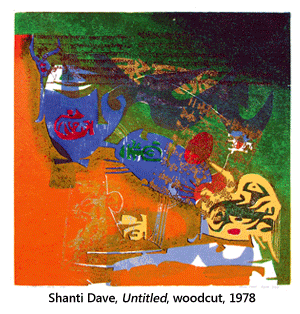 Looking at the long hours that the painter spent in the special studio built for him and his team in Baroda, and his frequent journeys to nearby kingdoms in Saurashtra and Rajasthan to bag more commissions from the royal families there, the then Baroda Diwan is believed to have advised the painter to find out more about the new technology developed in Europe, especially Germany, where one could make several copies of the same work and thus reach out to more buyers at a fraction of the price of an unique original. This is believed to have set the painter thinking and ultimately travelling to Europe in search of printing houses. The rest, as we all know, is history.
Looking at the long hours that the painter spent in the special studio built for him and his team in Baroda, and his frequent journeys to nearby kingdoms in Saurashtra and Rajasthan to bag more commissions from the royal families there, the then Baroda Diwan is believed to have advised the painter to find out more about the new technology developed in Europe, especially Germany, where one could make several copies of the same work and thus reach out to more buyers at a fraction of the price of an unique original. This is believed to have set the painter thinking and ultimately travelling to Europe in search of printing houses. The rest, as we all know, is history.
Talking of history, a number of interesting quotes and anecdotes about the early days of art printmaking in Baroda can be had from the out-of-print book, Contemporary Art in Baroda, edited by G M Sheikh, from the chapter titled, A Post-Independence Initiative in Art, by Nilima Sheikh. It notes that in the 1950s, (the Faculty was established in 1949-50) woodcut and linocut were the first and popular printmaking mediums and printmakers experimenting with it were Vinodray Patel, Haroon Khimani, Shanti Dave, Jyoti Bhatt, G M Sheikh, and Jayant Parikh. "Experimenting" might be a rather tame way to describe what these artists did, they worked on large prints (with single/multiple wood or lino blocks) and "complex graphic schemes in colour", 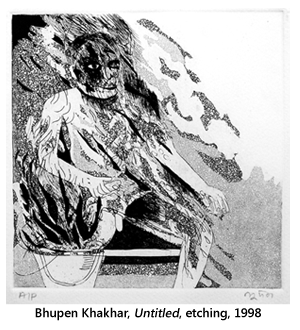 using large sheets of paper to print on, and if these were not available, used large sheets of cotton cloth! And as if this was not enough, the cotton sheets were often printed with pressure from their own feet. A 6 x 6 linocut made by Sheikh was "foot-printed" with photographer-writer-artist Navroze Contractor dancing on it, joined in by others!
using large sheets of paper to print on, and if these were not available, used large sheets of cotton cloth! And as if this was not enough, the cotton sheets were often printed with pressure from their own feet. A 6 x 6 linocut made by Sheikh was "foot-printed" with photographer-writer-artist Navroze Contractor dancing on it, joined in by others!
From the mid-1960s to the early 70s, Sheikh, Bhupen Khakhar, Jyoti Bhatt and several other artists in Baroda with a profound interest in Gujarati literature, joined hands with eminent author Suresh Joshi (teaching in the Gujarati Department at the M S University) to bring out a literary magazine called Kshitij. Later, another one on art and ideas, called Vrishchik, was also brought out edited by Sheikh and Khakhar. Both these magazines used prints by the Baroda artists for their cover and for illustrations in the inside pages. Sheikh persuaded the treadle printers "to mount lino in place of the conventional metal plate on the wooden block and have it run directly on the press". There were 500 copies of each magazine printed and they often had a print added in separately "as a special enclosure". An issue of Kshitij also had a silkscreen-printed cover, tried out experimentally for the first time, before silkscreen printing was officially introduced at the Faculty of Fine Arts.
The book credits Demy Hunt, a young American from LA who was at Baroda in the early 1960s, for introducing silkscreen printing there.  (Bhupendra Karia was then the Head, Graphics Department.) Demy had the silkscreen printing equipment with her and she had learnt the techniques under a teacher-nun at her school, Sister Marie Coretta, who later became quite a well-known printmaker. Though Demy was only interested in silkscreen printing in a rudimentary way...more as a way of getting bright colours and motifs printed on the surface rather than exploring its several intricacies...she did manage to get a number of artists in Baroda interested in the medium. However it was still a few years before Jyoti Bhatt actually saw a complete screen-printing unit in actual operation (at a relative's in Mumbai). On his return to Baroda, Bhatt got together artists like Feroze Katpitia, V S Patel, Vinodray Patel and P D Dhumal, and using what he had seen and absorbed in Mumbai they put together a silkscreen unit. Soon they moved beyond the basic stencil techniques to explore "possibilities of tonal and colour gradations and photographic methods" thus taking the craft much further.
(Bhupendra Karia was then the Head, Graphics Department.) Demy had the silkscreen printing equipment with her and she had learnt the techniques under a teacher-nun at her school, Sister Marie Coretta, who later became quite a well-known printmaker. Though Demy was only interested in silkscreen printing in a rudimentary way...more as a way of getting bright colours and motifs printed on the surface rather than exploring its several intricacies...she did manage to get a number of artists in Baroda interested in the medium. However it was still a few years before Jyoti Bhatt actually saw a complete screen-printing unit in actual operation (at a relative's in Mumbai). On his return to Baroda, Bhatt got together artists like Feroze Katpitia, V S Patel, Vinodray Patel and P D Dhumal, and using what he had seen and absorbed in Mumbai they put together a silkscreen unit. Soon they moved beyond the basic stencil techniques to explore "possibilities of tonal and colour gradations and photographic methods" thus taking the craft much further.
One significant fall-out of Demy's introduction of silkscreen printing in Baroda was the effect it had on Vivan Sundaram, then a student at the FFA. He immediately understood the possibilities of its reach, and it was when he went to Slade School, London, after Baroda, and was seriously influenced by the wider socio-political implications of art-making, that he was able to turn that understanding into practice: "For several years, the silkscreen reproductions that Vivan made from his drawings to make them widely accessible became symbols of awareness of the political potential of the visual image and of diversified possibilities of silkscreen." Always looking at innovative ways in which to make art accessible to the larger public, Vivan also worked out a practical, implementable system wherein large groups of artist-printmakers would work together to create an edition of original prints. Vivan successfully demonstrated this system by organizing two workshops at Baroda through the efforts of friends and artists. Editions of 50 works were printed, the prints exhibited in the Faculty gallery (a non-commercial place, to reduce overheads) and prints were made available at Rs 50 per piece (with a discount if the whole edition was bought). These workshops "can now be seen as conceptual and organizational landmarks in printmaking in India and prototypes of organizational effort since." Prof K G Subramanyan went a step further and produced several silkscreen-printed books for children, 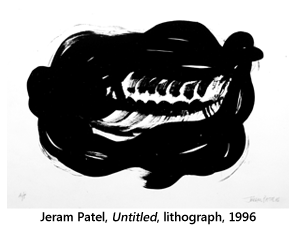 written and illustrated by himself, to be sold in the Fine Arts Fair at Baroda. The entire series has recently been reproduced by Seagull.
written and illustrated by himself, to be sold in the Fine Arts Fair at Baroda. The entire series has recently been reproduced by Seagull.
Lithography, in addition to linocuts, was also quite popular especially with those artists whose drawing hand worked with flourish and energy. Amongst these was Kishor Wala, who in spite of his physical handicaps, especially malformed hands, used a fluid brush to draw deftly upon the litho slabs. Intaglio came to Baroda in the 1970s. Again, Jyoti Bhatt was the main mover and shaker. He returned from the Pratt institute and Tamarind Workshop, USA, in 1966, having learnt and practised the subtle intricacies of intaglio etching, completely intrigued and enamoured of the same. He had made elaborate drawings of the presses he had worked on at Tamarind and brought them with him. Back home, with the help of Feroze Katpitia and a mechanic friend, Bharat Patel, these drawings were turned into engineering drawings and an actual etching press was hammered into place. Etching tools were sourced from the Lohar Chawl in Mumbai, and locally from the Nathdwarawala tool shop. (Bharat Patel's son, Dilip continues to custom-design printmaking presses for artists at his father's engineering works facility (Ravi Engineering Works) in Nagarwada, Baroda, even today.
Intaglio printing interested several other painters and sculptors in Baroda -- Jeram Patel, Rajnikant Panchal, Devraj Dakoji, Vrundavan Solanki, Dattatray Apte, Anjana Mehra and many others. Naina Dalal and Jayant Parikh actually set up small presses in their homes to work and experiment as they desired.
However, the printmakers of extreme significance from this early era of printmaking at Baroda were, without doubt, Laxma Goud, and to a certain extent,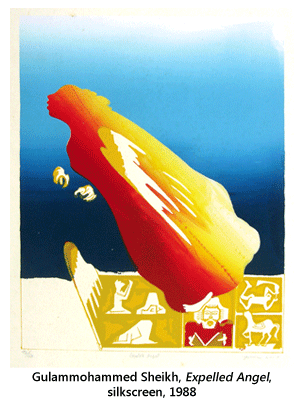 DLN Reddy and Rini Dasgupta Dhumal. Laxma Goud came to Baroda in 1963 to study mural design under Subramanyan. Goud was influenced in Baroda not just by Subramanyan from whom he "learnt the value of craft, of acuity in draughtsmanship, and, most of all, to look around himself for a perception of his identity", but also Jeram Patel from whom he understood how "Energy was identified as phallic puissance". Laxma combined both technical prowess and visual content with such potency, never letting one override the other, that the sheer primitive strength of tension between the two helped him create the kind of powerful, fecund prints that he made and continues to make even today. He brought to Indian printmaking a kind of overarching maturity, as if moving it from infancy straight into adulthood without the need for the wonder years in-between. His prints, worked in great detail, strong on earthy emotional content and brimming with sensuality, will always be amongst the best examples of Indian printmaking.
DLN Reddy and Rini Dasgupta Dhumal. Laxma Goud came to Baroda in 1963 to study mural design under Subramanyan. Goud was influenced in Baroda not just by Subramanyan from whom he "learnt the value of craft, of acuity in draughtsmanship, and, most of all, to look around himself for a perception of his identity", but also Jeram Patel from whom he understood how "Energy was identified as phallic puissance". Laxma combined both technical prowess and visual content with such potency, never letting one override the other, that the sheer primitive strength of tension between the two helped him create the kind of powerful, fecund prints that he made and continues to make even today. He brought to Indian printmaking a kind of overarching maturity, as if moving it from infancy straight into adulthood without the need for the wonder years in-between. His prints, worked in great detail, strong on earthy emotional content and brimming with sensuality, will always be amongst the best examples of Indian printmaking.
On the other hand, his compatriot from Andhra, DLN Reddy, also equally strong in technique and content, worked on a more sophisticated, delicately nuanced content plane. Reddy came to study at Baroda a few years after Laxma did. His engagement with the medium was in more subtle, understated and intellectual ways, so that it helped him create urban landscapes, of within and without, hinting at conflicts, gently nudging the viewer into awareness of the several little highlights of the print that make it really priceless. Reddy's prints are very much like him quiet, thoughtful, hard-working. And very valuable.
Rini Dasgupta Dhumal studied at Baroda where her interest in printmaking was tweaked to such an extent that she went to Santiniketan to study it further under Somnath Hore and then in 1975 to Paris at Hayter's Atelier 17. She returned qualified in making coloured viscosity prints and really fine etchings. Her marriage to PD Dhumal surely must have worked at shoring her strong and continued interest in printmaking. Purshottam Dhumal himself is extraordinarily knowledgeable about printmaking, the craft, the materials, the equipment and the infrastructure, though he may not have much work to show for it (he has been more active in the last few years however). 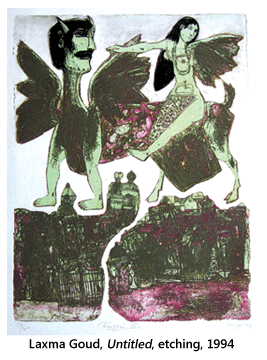 On the other hand, Rini prints as if there is no tomorrow and she has a voluminous body of work to her credit, work that has explored each aspect of traditional printmaking, including printmaker's books. Rini's prints are technically extremely competent, but the content is where she often weakens and loses out. For years, her works have featured briskly worked triangular faced women with a parrot or a fish, and different permutations thereof. These exercises in portraiture were simple and straightforward and most of her work has remained in the same orbit, with some changes now and then.
On the other hand, Rini prints as if there is no tomorrow and she has a voluminous body of work to her credit, work that has explored each aspect of traditional printmaking, including printmaker's books. Rini's prints are technically extremely competent, but the content is where she often weakens and loses out. For years, her works have featured briskly worked triangular faced women with a parrot or a fish, and different permutations thereof. These exercises in portraiture were simple and straightforward and most of her work has remained in the same orbit, with some changes now and then.
What I remember of Rini of the 1980s is the extraordinary passion she brought for the medium, the way she fought for printmaking to get the same kind of importance as painting and sculpture at the Faculty of Fine Arts, Baroda. But for some reason, the Faculty still offers only post-graduate diploma/degree in Graphics; even when Rini and Dhumal have in turn headed the Department for a number of years. Why, I do not know. Together, she and Dhumal have established Printmakers, a well-equipped printmaking studio facility in Baroda, so that the many artist-printmakers who in the past had no choice but to go back to painting for lack of printing infrastructure could continue to make prints. If I am not mistaken, Printmakers was where Bhupen Khakhar's first printmaker-book, Phoren Soap, was printed, sometime in the mid-1990s, introducing the idea of printmaker-books to Baroda for the first time.
Images courtesy: Archer Gallery, Ahmedabad